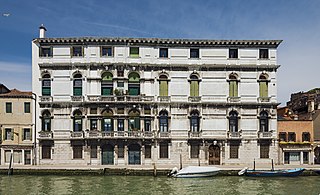
Eleonora Giulia Amalia Duse, often known simply as Duse, was an Italian actress, rated by many as the greatest of her time. She performed in many countries, notably in the plays of Gabriele D'Annunzio and Henrik Ibsen. Duse achieved a unique power of conviction and verity on the stage through intense absorption in the character, "eliminating the self" as she put it, and letting the qualities emerge from within, not imposed through artifice.

Andrea Palladio was an Italian Renaissance architect active in the Venetian Republic. Palladio, influenced by Roman and Greek architecture, primarily Vitruvius, is widely considered to be one of the most influential individuals in the history of architecture. While he designed churches and palaces, he was best known for country houses and villas. His teachings, summarized in the architectural treatise, The Four Books of Architecture, gained him wide recognition.

The Grand Canal is a channel in Venice, Italy. It forms one of the major water-traffic corridors in the city.

The Ca' d'Oro or Palazzo Santa Sofia is a palace on the Grand Canal in Venice, northern Italy. One of the older palaces in the city, its name means "golden house" due to the gilt and polychrome external decorations which once adorned its walls. Since 1927, it has been used as a museum, as the Galleria Giorgio Franchetti.

The Barbaro family was a patrician family of Venice. They were wealthy and influential and owned large estates in the Veneto above Treviso. Various members were noted as church leaders, diplomats, patrons of the arts, military commanders, philosophers, scholars, and scientists.

Venetian Gothic is the particular form of Italian Gothic architecture typical of Venice, originating in local building requirements, with some influence from Byzantine architecture, and some from Islamic architecture, reflecting Venice's trading network. Very unusually for medieval architecture, the style is at its most characteristic in secular buildings, with the great majority of surviving examples of the style being secular.

The Palazzo Dario is a palace located between the Palazzo Barbaro Wolkoff and the narrow Rio delle Torreselle on the Grand Canal in the sestiere of Dorsoduro, of the city of Venice, Italy. The palace was built in the Venetian Gothic style and was renovated in Renaissance style.

Palazzo Salviati is a palace on the Grand Canal in the Dorsoduro district in Venice, northern Italy. It is situated between the Palazzo Barbaro Wolkoff and Palazzo Orio Semitecolo Benzon.

Palazzo Contarini Dal Zaffo, also known as Palazzo Contarini Polignac is a large palace in Venice, located in the Dorsoduro district, overlooking the Grand Canal, in an intermediate position between Palazzo Brandolin Rota and Palazzo Balbi Valier.

Palazzo Contarini Fasan is a small Gothic palace in Venice, Italy, located in the San Marco district and overlooking the Grand Canal. The palazzo is also called the House of Desdemona.

Palazzo Malipiero-Trevisan is a Renaissance palace in Venice, Italy located in the Castello district, on the south-eastern side of campo Santa Maria Formosa and separated from it by the Santa Maria Formosa river.

Palazzo Falier is a civil building located in Venice, Italy in the Cannaregio district. The palazzo is particularly known for having been the home of Marin Falier, Doge of the Republic of Venice, who was executed for attempting a coup d'état.

Palazzo Michiel del Brusà is a palace located in Venice, more precisely in the Cannaregio district, and overlooking the Grand Canal. The building is located between Palazzo Michiel dalle Colonne and Palazzo Smith Mangilli Valmarana.

Palazzo Erizzo Nani Mocenigo is a palace in Venice located in the San Marco district and overlooking the Grand Canal between Palazzo Da Lezze and Palazzo Contarini delle Figure.

Palazzo Orio Semitecolo Benzon is a Gothic palace in Venice, Italy, built in the 14th century. The palazzo is located in the Dorsoduro district and overlooks the Grand Canal between Casa Santomaso and Casa Salviati.

Palazzo Surian Bellotto is a Baroque palace in Venice, Italy. The palazzo is located in the Cannaregio district and overlooks the Cannaregio Canal.

Palazzo Priuli Ruzzini Loredan, also called Palazzo Loredan at Campo Santa Maria Formosa, is a late 16th-century palace located at Campo Santa Maria Formosa in the Castello district of Venice, northern Italy, characterised by features of Renaissance and Baroque-style architecture on its façades.

Palazzo Mocenigo Gambara is a palace in Venice, located in the Dorsoduro district and overlooking the Grand Canal, between the Contarini Palazzi degli Scrigni and Corfù and Palazzo Querini alla Carità, not far from the Gallerie dell'Accademia and in front of Palazzo Giustinian Lolin.

Palazzo Bolani Erizzo is an ancient Venetian palace of the 13th century, built along the Grand Canal in the Cannaregio district. It stands wall to wall with Palazzo Dolfin.

Palazzo Gradenigo is a palace in Venice, located in the Santa Croce district, near Palazzo Soranzo Cappello and the church of San Simeone Profeta, and overlooking Rio Marin.


























